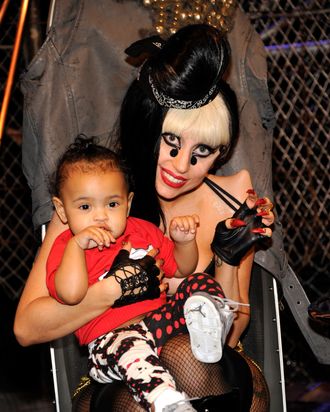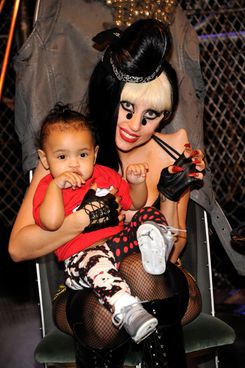

Over the past two weeks, just as Christian doomsayers were being proved false, Freddie MercuryÔÇÖs 1984 prophecy came true for a whole news cycle: all we heard was Radio Gaga. The entire media sphere was tuned in to the station ÔÇö American Idol, 60 Minutes, Saturday Night Live, The View ÔÇö all visited by the supernova-ing Lady Gaga as she promoted her new Born This Way CD and its message of self-acceptance. Announcing the singerÔÇÖs top ranking on ForbesÔÇÖ ÔÇ£Most PowerfulÔÇØ list, The ViewÔÇÖs Sherri Shepherd boiled the moment down to just one stat: ÔÇ£You have knocked Oprah Winfrey down to number two, girl.ÔÇØ Sort of. The ÔÇ£powerÔÇØ calculus by which Forbes ranks the $90 millionÔÇôearning Gaga over the $290 millionÔÇôearning Oprah isnÔÇÖt much more scientific than the one Time uses to gauge ÔÇ£influenceÔÇØ (double the Twitter followers, add half all Facebook friends). But this nominal dethronement does speak to what must happen to an artist around her 9 millionth Twitter follower, when it sinks in that all your little monsters are actually listening; you donÔÇÖt depose Oprah so much as become her. On Monday, Gaga told The ViewÔÇÖs matriarchal Rushmore that with fame, ÔÇ£suddenly thereÔÇÖs lots of pressure and you have to be a role model and I had to look inside myself and I had to say, ÔÇÿWell, what do I have to offer?ÔÇÖÔÇØ Let us postulate that the last place a 25-year-old pop star should look is inside herself. Let us add that the last role she should assume is GagaÔÇÖs stated one: ÔÇ£a vehicle for the voice of my fans.ÔÇØ
From the moment this club-kid version of Carole King launched as pop star, her talent was as obvious as her strategy: grimed-up ADD Bowie/Madonna boilerplate (glam, perv, religious iconography), fine-tuned by industry mandarins, and plugged into the mainframe. The only surprise was how well the machine still worked. ÔÇ£Bad Romance,ÔÇØ ÔÇ£Paparazzi,ÔÇØ and other Gaga songs outshone their chart-topping neighbors without trying, her raw-meat and Kermit couture delighted and grossed out, and the studious provocateur kept things arch and chilly. What a difference a million followers makes. Born This Way is a solid collection of club thumpers, using Black Eyed PeasÔÇÖ dance-mix aggregation tactics with infinitely better punchlines. But if her art-school team still skews more Banksy than Mr. Brainwash, Lady GagaÔÇÖs more personal platform has taken on a creepily pan-inoffensive monotone, the same one heard in her tweeted response to the death of Bin Laden: ÔÇ£Watching CNN, what a historical moment in the fight against hatred.ÔÇØ Meanwhile, the same singer whose just-barely pixelated crotch shot in 2010ÔÇÖs ÔÇ£TelephoneÔÇØ video somehow read elusive is now nurturing her little-monster acolytes with music thatÔÇÖs more and more audibly regressive, sharing an inner-child message she summarized on The View: ÔÇ£Be yourself and love who you are and be proud because you were born this way.ÔÇØ
Born what way? ItÔÇÖs obvious what self-acceptance should and does sound like for an Italian-American named Stefani Germanotta who was born in 1986, the year the smash True Blue album coronated Madonna Ciccone. But while Lady Gaga always looked aughts and sounded late-eighties, the similarity between her albumÔÇÖs title song and MadonnaÔÇÖs ÔÇÿ89 ÔÇ£Express YourselfÔÇØ is only the most noted of Born This WayÔÇÖs apparent Freudian slips; as Gaga told an interviewer, the Madonna-isms that are both too profound and superficial came to her in a flood of unmediated inspiration that the ÔÇ£magical message songÔÇØ ÔÇ£Born This WayÔÇØ opened like a portal or, er, ÔÇ£an immaculate conception.ÔÇØ Whether or not sheÔÇÖs kidding about their genesis, by the time the ÔÇØLa Isla BonitaÔÇØ Italo-espa├▒ol of ÔÇ£AmericanoÔÇØ segues to the echoing ÔÇ£Like a PrayerÔÇØ verse of ÔÇ£Fashion of His Love,ÔÇØ then to the ÔÇ£Oh FatherÔÇØ declaration of ÔÇ£Bloody Marry,ÔÇØ and then to the ÔÇ£VogueÔÇØ-ish clipped spoken chorus of ÔÇ£Black Jesus,ÔÇØ this message sounds like a faint echo of an early-nineties Act Up slogan. And unlike MadonnaÔÇÖs celebratory mode of addressing that eraÔÇÖs dead-serious gender issues, Lady GagaÔÇÖs arch/sincere toggle switch for IM-ing uplift comes off strikingly didactic. (Thank God for lines like ÔÇ£Jesus is the new black.ÔÇØ)
If our times have qualified anti-hate and pro-self-love as messages, Gaga is surely helping her marginalized little monsters ÔÇö all 10 million of them. But when the message leads the medium, pop music always suffers, and ÔÇ£it gets betterÔÇØ is not a killer hook. A little over a year ago, then-23-year-old Lady Gaga gave this magazine the Warhol party line: ÔÇ£In art, as in music, thereÔÇÖs a lot of truth ÔÇö and then thereÔÇÖs a lie. The artist is essentially creating his work to make this lie a truth, but he slides it in amongst all the others. The tiny little lie is the moment I live for.ÔÇØ This is as much message as any superstar should need. Lady Gaga is too smart and talented to star in an after-school special with wardrobe borrowed from RuPaulÔÇÖs Drag Race, which is what the spokesman role does to her persona. As they say, if one kidÔÇÖs life is saved by Born This WayÔÇôera Lady Gaga (morphing as you read this) itÔÇÖs all worth it. Perhaps some algorithm can weigh this against the one gay, sickly Catholic Pittsburgh coal-minerÔÇÖs son who, had he access to GagaÔÇÖs Twitter, might not have had to become Andy Warhol. LetÔÇÖs hope Lady Gaga rediscovers her love of tiny little lies.

